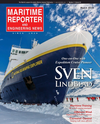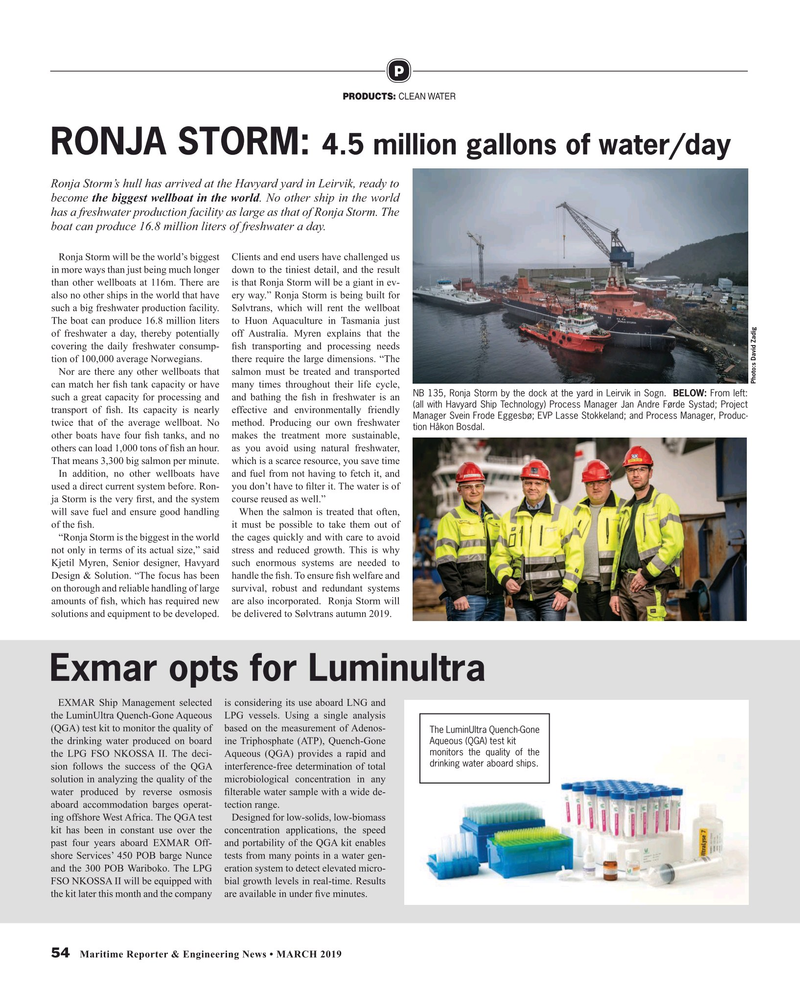
Page 54: of Maritime Reporter Magazine (March 2019)
Cruise Shipping
Read this page in Pdf, Flash or Html5 edition of March 2019 Maritime Reporter Magazine
P
PRODUCTS: CLEAN WATER
RONJA STORM: 4.5 million gallons of water/day
Ronja Storm’s hull has arrived at the Havyard yard in Leirvik, ready to become the biggest wellboat in the world. No other ship in the world has a freshwater production facility as large as that of Ronja Storm. The boat can produce 16.8 million liters of freshwater a day.
Ronja Storm will be the world’s biggest Clients and end users have challenged us in more ways than just being much longer down to the tiniest detail, and the result than other wellboats at 116m. There are is that Ronja Storm will be a giant in ev- also no other ships in the world that have ery way.” Ronja Storm is being built for such a big freshwater production facility. Sølvtrans, which will rent the wellboat
The boat can produce 16.8 million liters to Huon Aquaculture in Tasmania just of freshwater a day, thereby potentially off Australia. Myren explains that the covering the daily freshwater consump- ? sh transporting and processing needs tion of 100,000 average Norwegians. there require the large dimensions. “The
Nor are there any other wellboats that salmon must be treated and transported
Photo:s David Zadig can match her ? sh tank capacity or have many times throughout their life cycle,
NB 135, Ronja Storm by the dock at the yard in Leirvik in Sogn. BELOW: From left: such a great capacity for processing and and bathing the ? sh in freshwater is an (all with Havyard Ship Technology) Process Manager Jan Andre Førde Systad; Project transport of ? sh. Its capacity is nearly effective and environmentally friendly
Manager Svein Frode Eggesbø; EVP Lasse Stokkeland; and Process Manager, Produc- twice that of the average wellboat. No method. Producing our own freshwater tion Håkon Bosdal. other boats have four ? sh tanks, and no makes the treatment more sustainable, others can load 1,000 tons of ? sh an hour. as you avoid using natural freshwater,
That means 3,300 big salmon per minute. which is a scarce resource, you save time
In addition, no other wellboats have and fuel from not having to fetch it, and used a direct current system before. Ron- you don’t have to ? lter it. The water is of ja Storm is the very ? rst, and the system course reused as well.” will save fuel and ensure good handling When the salmon is treated that often, of the ? sh. it must be possible to take them out of “Ronja Storm is the biggest in the world the cages quickly and with care to avoid not only in terms of its actual size,” said stress and reduced growth. This is why
Kjetil Myren, Senior designer, Havyard such enormous systems are needed to
Design & Solution. “The focus has been handle the ? sh. To ensure ? sh welfare and on thorough and reliable handling of large survival, robust and redundant systems amounts of ? sh, which has required new are also incorporated. Ronja Storm will solutions and equipment to be developed. be delivered to Sølvtrans autumn 2019.
Exmar opts for Luminultra
EXMAR Ship Management selected is considering its use aboard LNG and the LuminUltra Quench-Gone Aqueous LPG vessels. Using a single analysis (QGA) test kit to monitor the quality of based on the measurement of Adenos-
The LuminUltra Quench-Gone the drinking water produced on board ine Triphosphate (ATP), Quench-Gone
Aqueous (QGA) test kit monitors the quality of the the LPG FSO NKOSSA II. The deci- Aqueous (QGA) provides a rapid and drinking water aboard ships.
sion follows the success of the QGA interference-free determination of total solution in analyzing the quality of the microbiological concentration in any water produced by reverse osmosis ? lterable water sample with a wide de- aboard accommodation barges operat- tection range. ing offshore West Africa. The QGA test Designed for low-solids, low-biomass kit has been in constant use over the concentration applications, the speed past four years aboard EXMAR Off- and portability of the QGA kit enables shore Services’ 450 POB barge Nunce tests from many points in a water gen- and the 300 POB Wariboko. The LPG eration system to detect elevated micro-
FSO NKOSSA II will be equipped with bial growth levels in real-time. Results the kit later this month and the company are available in under ? ve minutes. 54 Maritime Reporter & Engineering News • MARCH 2019
MR #3 (50-57).indd 54 3/8/2019 11:19:10 AM

 53
53

 55
55
